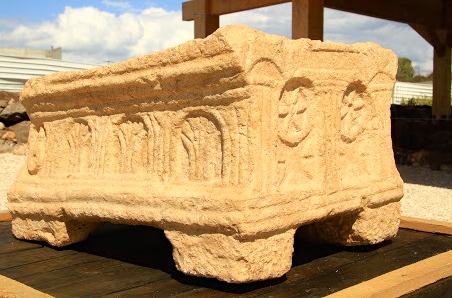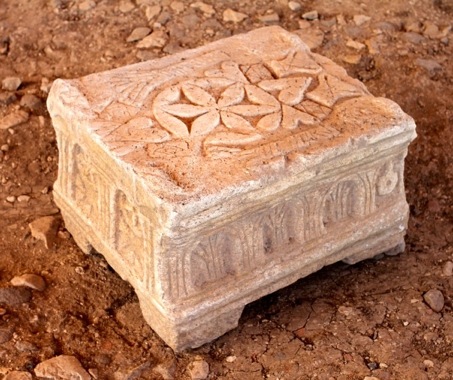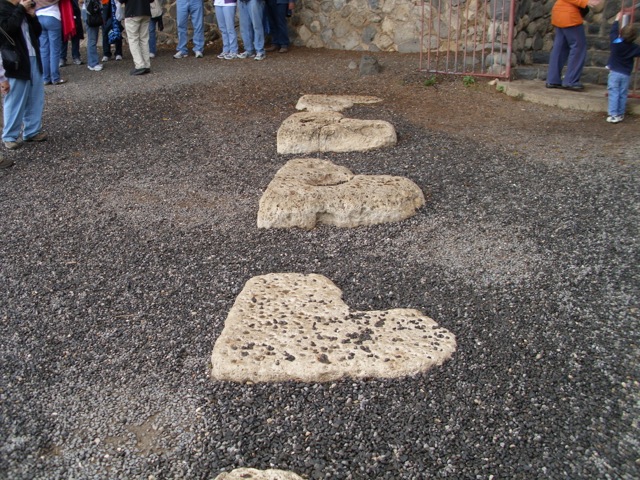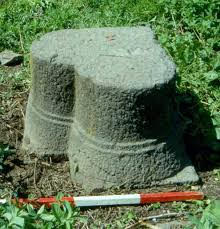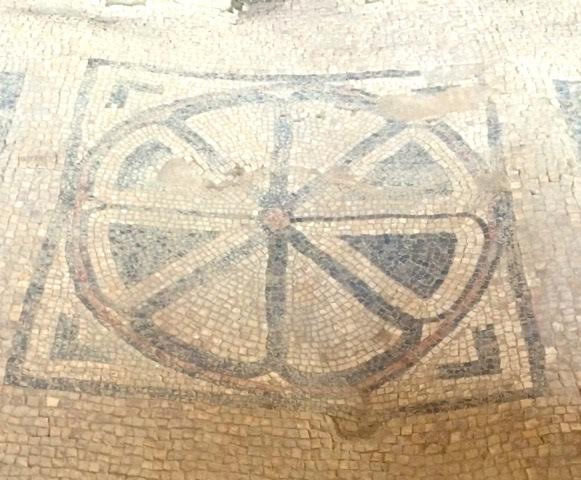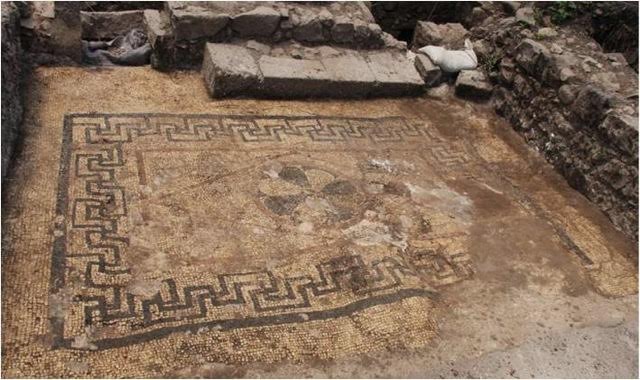The Magdala Stone
Have Archaeologists Uncovered More Evidence of Early Believers?
(Magdala Stone recently found at Magdala)
It is well known from the Bible that Jesus performed much of His ministry around the Sea of Galilee. His mother, Mary, grew up in Zippori in the region of Nazareth and Joseph was from the city of Nazareth. Nazareth is very close to the Sea of Galilee. Jesus called many of His disciples from the Sea of Galilee. It appears that at least seven of the disciples of Jesus were fishermen (John 21:2-3). Jesus performed many miracles around the Sea of Galilee including turning the water into wine (John 2:1-11) feeding 5,000 with a young boys lunch (Matthew 14:13-21), and walking on the water (Matthew 14:22-33).
Magdala is one of the cities on the shore of the Galilee where Jesus ministered. After Jesus miraculously fed 4,000 men plus women and children with seven loaves and fishes, He took a boat across the sea to Magdala (Matthew 15:39). Magdala was a fishing village on the western shore of the sea.
As with most ancient cities in the Galilee, Magdala had a strong Jewish presence. An ancient synagogue has been recently discovered there. Jesus regularly taught in the synagogues where He ministered. Is it possible that Jesus taught in this synagogue?
Magdala is one of the cities on the shore of the Galilee where Jesus ministered. After Jesus miraculously fed 4,000 men plus women and children with seven loaves and fishes, He took a boat across the sea to Magdala (Matthew 15:39). Magdala was a fishing village on the western shore of the sea.
As with most ancient cities in the Galilee, Magdala had a strong Jewish presence. An ancient synagogue has been recently discovered there. Jesus regularly taught in the synagogues where He ministered. Is it possible that Jesus taught in this synagogue?
(The Magdala stone)
One of the most remarkable discoveries at this site is a large stone that is believed to have been used as a podium by the priest while he read the Torah scroll in the synagogue. This “Magdala stone” is approximately 24 inches long, 20 inches wide, and 18 inches tall. It would have been the right size for which a priest to lay a scroll to read it while he was sitting.
The outstanding feature of the stone is the various icons carved into it. The icons around the sides of the stone are familiar Temple icons depicting the Menorah, the pillars of the Temple, and other Temple articles. The most interesting surface of the stone is the top. The central icon on the top of the stone is the six-leaf rosette, which is the icon of the House of David. [1] The six-leaf rosette is surrounded by heart-shaped icons.
The heart-shaped icons are not as common as the familiar Temple icons. Most of the heart-shaped icons I have seen are in the Galilee region of Israel. Please do not confuse the heart-shaped icons with the pomegranates. The two look much alike but the pomegranate normally has a vine attached to it and the “V” shape in the top is not as pronounced. Icons are based on familiar, easily recognizable features. One of the most distinguishing features of the Galilee is the anchor stones found on the north shore of the Sea of Galilee.
[1] See my previous article on the six-leaf rosette.
The outstanding feature of the stone is the various icons carved into it. The icons around the sides of the stone are familiar Temple icons depicting the Menorah, the pillars of the Temple, and other Temple articles. The most interesting surface of the stone is the top. The central icon on the top of the stone is the six-leaf rosette, which is the icon of the House of David. [1] The six-leaf rosette is surrounded by heart-shaped icons.
The heart-shaped icons are not as common as the familiar Temple icons. Most of the heart-shaped icons I have seen are in the Galilee region of Israel. Please do not confuse the heart-shaped icons with the pomegranates. The two look much alike but the pomegranate normally has a vine attached to it and the “V” shape in the top is not as pronounced. Icons are based on familiar, easily recognizable features. One of the most distinguishing features of the Galilee is the anchor stones found on the north shore of the Sea of Galilee.
[1] See my previous article on the six-leaf rosette.
(Heart-shaped anchor stones on the north shore of the Sea of Galilee)
It appears these ancient stones were used to tie the fishing boats to. These large heart-shaped stones are very remarkable because of their size and shape. They are certainly a distinguishing mark of the Galilee.
The ancient city of Gamla lies just north east of the Sea of Galilee. It was a stronghold of the Jews who revolted against Rome. The city was sieged by Rome in 67 A.D. The synagogue of Gamla has a very unusual feature that distinguishes it. The four corner pillars of the synagogue are heart-shaped in their cross section. If a person would cut a pillar in half horizontally and look at it from above, the pillars are heart-shaped. These heart shapes seem to be an icon characteristic of the Galilee region. The heart shape is the icon of the Galilee.
The ancient city of Gamla lies just north east of the Sea of Galilee. It was a stronghold of the Jews who revolted against Rome. The city was sieged by Rome in 67 A.D. The synagogue of Gamla has a very unusual feature that distinguishes it. The four corner pillars of the synagogue are heart-shaped in their cross section. If a person would cut a pillar in half horizontally and look at it from above, the pillars are heart-shaped. These heart shapes seem to be an icon characteristic of the Galilee region. The heart shape is the icon of the Galilee.
(Heart Shaped Pillars of Gamla Synagogue)
The arrangement of the hearts on the Magdala stone is peculiar. The two square boxes with diamond shapes in the middle may represent the golden altar of incense in the Temple. The two symbols at the top end of the stone may represent the table of showbread. The interesting aspect of the icons on top of the Magdala stone is their configuration. There seems to be little symmetry to the icons. The obvious question to me is why are the hearts arranged around the six-leaf rosette in the random order that they are? They were arranged in the manner they were for a reason.
If a person stands back from the details of the top of the stone he can see that the heart shapes, the altar icons, the table of showbread icons and the six-leaf rosette form a fish shape. Why a fish? Magdala was a fishing town. Josephus records that in the first century the city had a population of 40,000 and was port to 230 fishing boats.
The Temple icons identify this stone and synagogue as belonging to Temple worshippers. The six-leaf rosette identifies these worshippers as followers of the heritage of the house of David. The hearts identify these worshippers as being in the Galilee. The fish pattern identifies these worshippers as from the fishing village of Magdala. The icons of this stone found in the synagogue in Magdala indicate that there were followers of God in Magdala before the first century. Chances are very good that Jesus saw this stone and possibly even used this stone in His ministry in Magdala.
Does this ancient synagogue have any connection to the followers of God today?
If a person stands back from the details of the top of the stone he can see that the heart shapes, the altar icons, the table of showbread icons and the six-leaf rosette form a fish shape. Why a fish? Magdala was a fishing town. Josephus records that in the first century the city had a population of 40,000 and was port to 230 fishing boats.
The Temple icons identify this stone and synagogue as belonging to Temple worshippers. The six-leaf rosette identifies these worshippers as followers of the heritage of the house of David. The hearts identify these worshippers as being in the Galilee. The fish pattern identifies these worshippers as from the fishing village of Magdala. The icons of this stone found in the synagogue in Magdala indicate that there were followers of God in Magdala before the first century. Chances are very good that Jesus saw this stone and possibly even used this stone in His ministry in Magdala.
Does this ancient synagogue have any connection to the followers of God today?
(Icon of the Early Church Found in the Synagogue in Magdala)
The tile mosaics in the floor of the synagogue of Magdala give us some clues about the relationship of the Early Church to this synagogue. There are two four-leaf rosettes found in the tile mosaic floors of the synagogue at Magdala. The four-leaf rosette is an icon that is morphed between the six-leaf rosette and the cross to represent followers of Christ in the Early Church.[1] The icon of the Early Church is in the synagogue at Magdala. Before Christ’ death, followers of God met in this synagogue. Christ taught in this synagogue. After His death, followers of God who accepted Jesus as the Messiah met in this synagogue. The icons found in the ancient synagogue at Magdala are breadcrumbs of the First Century Church. To find the Early Church we have to follow the breadcrumbs they left for us. They teach us much about the practice and beliefs of the earliest followers of Christ. There is a strong connection between the Early Church and Jewish synagogue movement.
[1] See my previous article on the four-leaf rosette.
[1] See my previous article on the four-leaf rosette.
(Icon of the Early Church Found in the Synagogue in Magdala)
© Dr. Steven L Smith 2016
